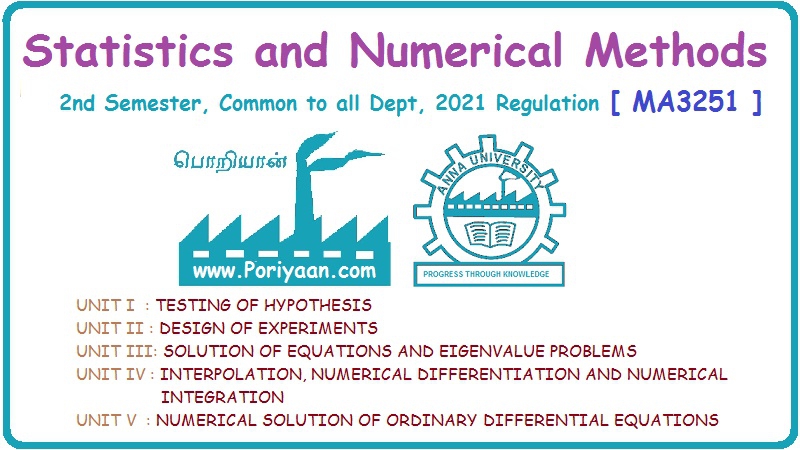Statistics and Numerical Methods: Unit II: Design of Experiments
Design of Experiments
Statistics
Experiments are a natural part of the engineering and scientific decision - making process.
UNIT – II
DESIGN OF EXPERIMENTS
Introduction
Experiments
are a natural part of the engineering and scientific decision - making process.
In a designed experiment the engineer makes deliberate or purposeful changes in
the controllable variables of the system or process, observes the resulting
system output data, and then makes an inference or decision about which
variables are responsible for the observed changes in output performance. Designed
experiments play a very important role in engineering design and development
and in the improvement of manufacturing processes. Generally when products and
processes are designed and developed with designed experiments, they enjoy
better performance, higher reliability and lower overall costs. Designed
experiments also play a crucial role in reducing the lead time for engineering
design and development activities.
An
experiment is just a test or series of tests. Experiments are performed in all
engineering and scientific disciplines and are an important part of the way, we
learn about how systems and processes work. The validity of the conclusions
that are drawn from an experiment depends, to a large extent, on how the
experiment was conducted. Therefore, the design of the experiment plays a major
role in the eventual solution of the problem that initially motivated the
experiment.
Experimental
units: The objects upon which the measurements are taken
are called experimental units. The design of an experiment implies one time
problem after selecting the factor combinations (treatments) to be employed in
an experiment. One must decide how the treatments should be assigned to the
experimental units.
Basic
principles in the Design of Experiment.
There
are three basic principles of an experimental design. They are
(1)
Randomization
(2)
Replication
(3)
Local control (error control)
1. Randomization
A
set of objects is said to be randomized, when they are arranged in random
order.
The
most frequently used assumption is the one which relates the observations
(units) are independent. We can judge the assumption by insisting on random
assignment of treatment to the experimental units. This randomization makes the
test valid by making it appropriate to analyse the data as though the
assumption of independent errors are true. Here, randomization permits us to
proceed as though independence is a fact but does not guarantee independence.
No amount of randomization will completely eliminate the errors but still
randomization is the best technique designed to attain the desired result.
Randomization
is like insurance. It is always a good idea and even sometimes better, than we
expect.
2. Replication
The
independent execution of an experiment more than once is called replication.
Replication
is necessary to increase the accuracy of estimates of the treatment effects. It
also provides an estimate of the error variance which is a function of the
differences among observations from experimental units, under identical
treatments. As the number of replication increases, the error is reduced. But,
it cannot be increased indefinitely as it increases cost of the experiments.
Also, due to limited resources, too many replications cannot be used.
Sensitivity of statistical methods for drawing inference also depends on the
number of replications. xo od bolavijom
3. Local control
To
provide adequate control of extraneous variables, another essential principle
used in the experimental design is the local control. This includes techniques
such as grouping, blocking and balancing of the experimental units, used in the
experimental design. By grouping, we mean combining sets of homogeneous plots
into groups, so that different manures may be used in different groups. The
number of plots in different groups need not necessarily be the same. By
blocking, we mean assigning the same number of plots in different blocks. The
plots in the same block may be assumed to be relatively homogeneous. We use as
many manures as the number of plots, in a block, in a random manner. By
balancing, we mean adjusting the procedures of grouping, blocking and assigning
the manures in such a manner that a balanced configuration is obtained. (fonos
10115) lonnoo Isso I (E)
Complete
Block Designs
There
are three such designs. They are
(1)
Completely Randomized Design
(2)
Randomized Block Design
(3)
Latin Square Design
Statistics and Numerical Methods: Unit II: Design of Experiments : Tag: : Statistics - Design of Experiments
Related Topics
Related Subjects
Statistics and Numerical Methods
MA3251 2nd Semester 2021 Regulation M2 Engineering Mathematics 2 | 2nd Semester Common to all Dept 2021 Regulation
